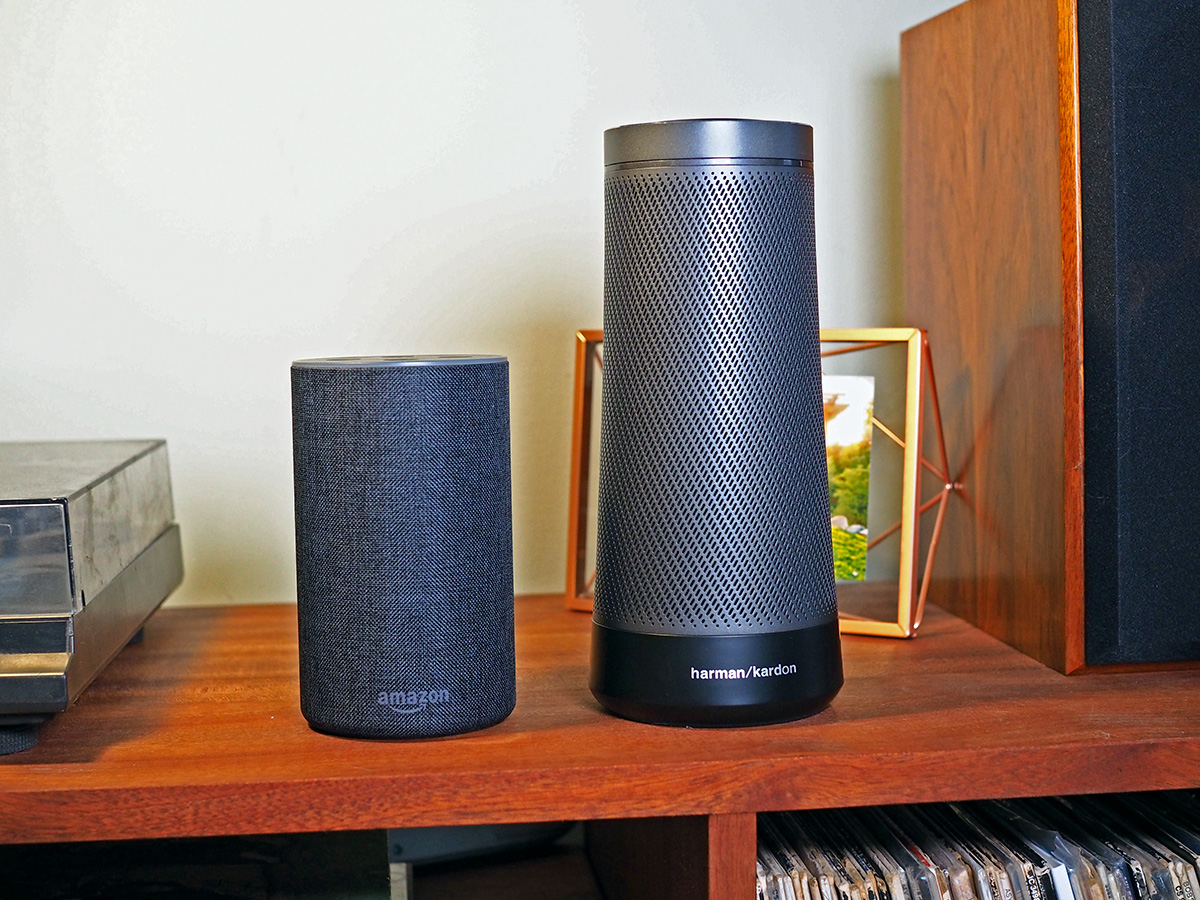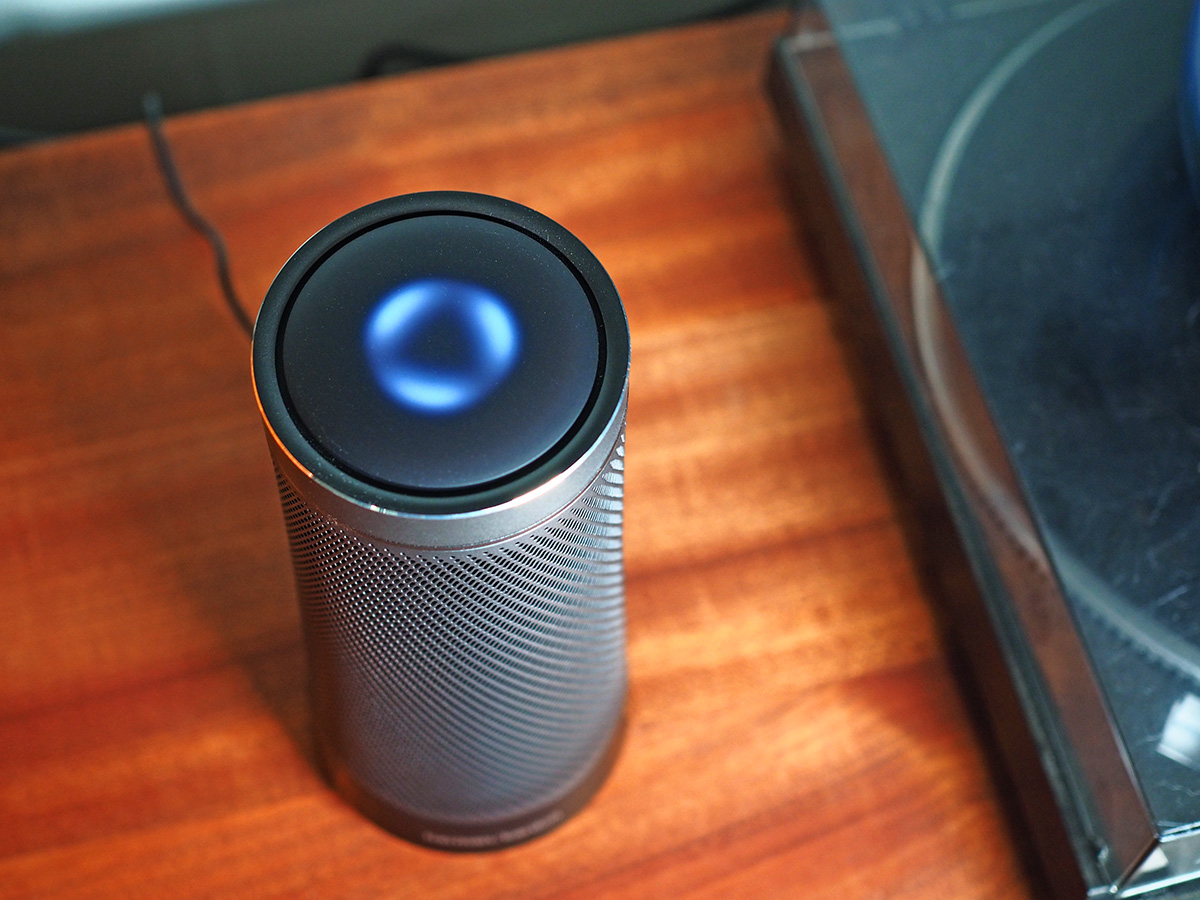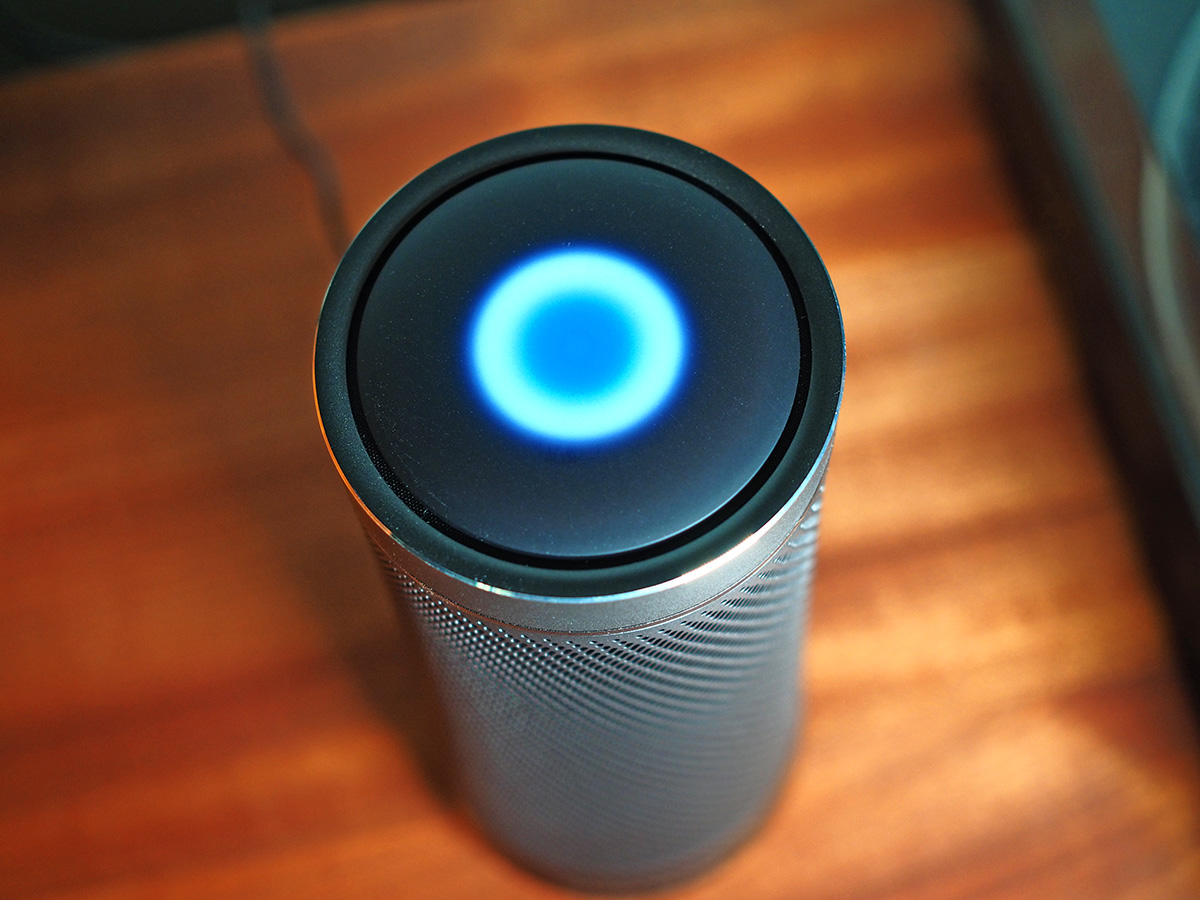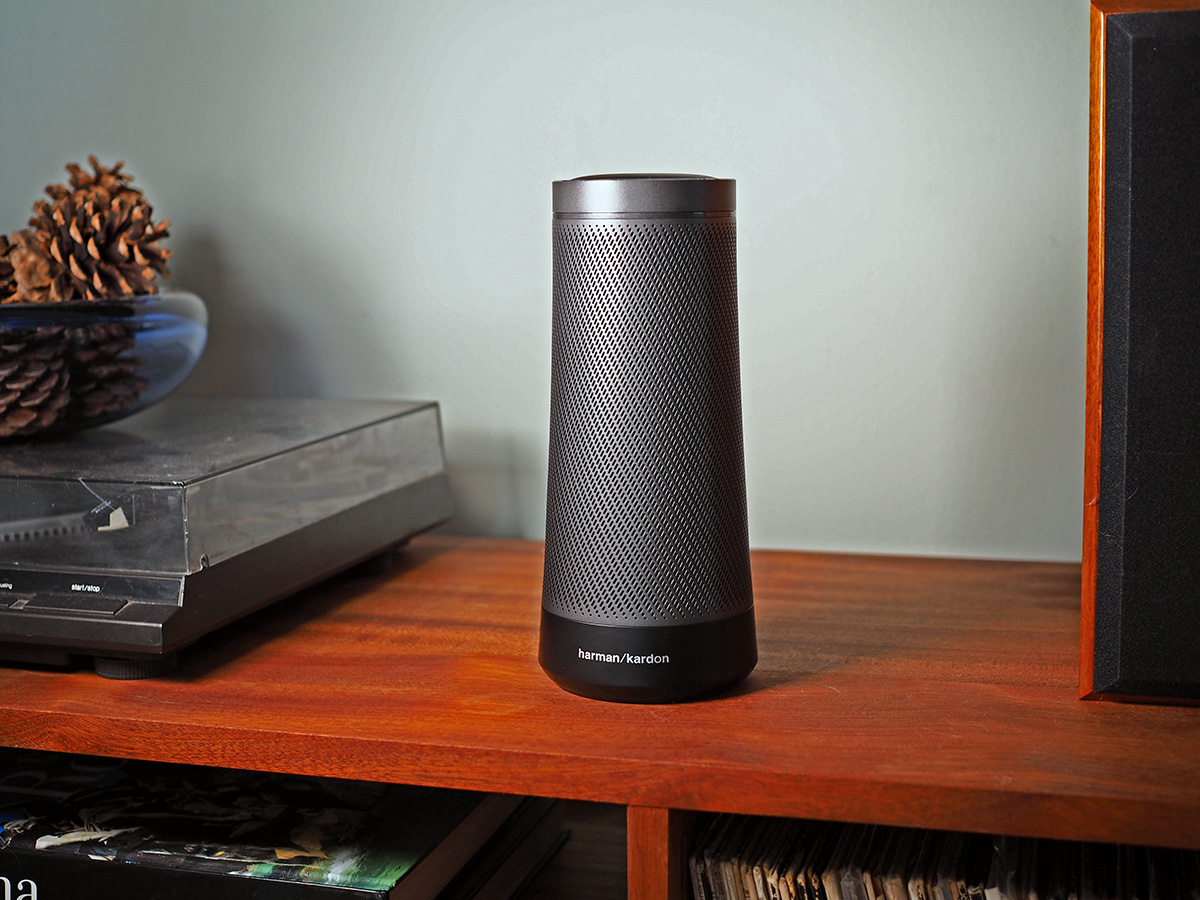Tom's Guide Verdict
The first smart speaker with Cortana sounds fantastic, but Microsoft's virtual assistant lags behind Alexa and Google Assistant.
Pros
- +
Excellent audio
- +
Cortana has good general knowledge
Cons
- -
Limited smart-home compatibility
- -
Very few skills
- -
Bulky power brick
Why you can trust Tom's Guide
Hey, Cortana, are you built into a speaker like Alexa? The Harman Kardon Invoke is the first smart speaker to come with Microsoft's personal assistant, and by all measures, is off to a strong start. It's one of the better-sounding speakers, but at $199, it's also one of the more expensive smart speakers, too. However, as a virtual assistant, Cortana has a long way to go before it catches up to Amazon and Google.
Design
Where Apple, Amazon and Google are all going for a softer, cloth-covered look with their speakers, the Invoke has a decidedly industrial feel — it resembles a cooling tower for a nuclear plant. The metal cylinder is mostly a dark-silver perforated metal, with a solid black base, and tapers toward the top. Measuring 9.5 inches tall and 4.2 inches in diameter, it's about the same size as the original Echo.
Like the original Amazon Echo, the top of the Invoke has a ring that can be twisted to raise or lower the volume; as you do so, LED lights hidden in the soft-touch top will turn on or off to indicate that things are getting louder or softer.
Tapping the top of the speaker activates Cortana, and she rewards you with a blue-and-white LED show, as well as some random factoid. Tapping this button will also let you do other things, such as pausing music playback, answering calls and more.

At the bottom of the speaker, where the power cord plugs in, is a button to turn off the microphone, as well as a Bluetooth pairing button.
Of all the smart speakers I've tested, the Invoke has the shortest power cord, and the largest power brick. What's more, the plug is built right into the brick, so it takes up a lot of room on an outlet.
Tapping the top of the speaker activates Cortana, and she rewards you with a blue-and white LED show, as well as some random factoid.
By default, it gives a ring or chime to indicate that it's heard you. You can change this in the Cortana app.
Audio: Pleasantly Great
Inside the Invoke are three 1.75-inch woofers and three 0.5-inch tweeters, which combined to produce some of the best audio I've heard from a smart speaker. After listening to jazz, rock and more, I'd say it's second only to the Sonos One in quality.
In general, songs were a bit bass-heavy, but the lower tones came through cleanly. This benefited some jazz tracks, such as Alexis Lombre's "Lonely Path" - I could hear every nuance in the bass and the piano.

However, sometimes the bass would overwhelm midtones: Clarence Clemmons' sax was a bit underwhelmed in Bruce Springsteen's "Hungry Heart." The vocals in Supertramp's "Long Way Home" felt a bit distant, too, but the bass was clear as a bell.
Itzhak Perlman's violin came through effortlessly; there was no distortion whatsoever with even the highest of the highest notes in Max Bruch's Violin Concerto No. 2 in D Minor.
Although the Invoke sounded great, getting music to the speaker is more of a challenge than with other smart speakers. At the moment, Cortana works only with iHeartRadio, Spotify, Groove Music and TuneIn. (However, Microsoft says it's working to integrate Pandora and others).
Inside the Invoke are three 1.75-inch woofers and three 0.5-inch tweeters, which combined to produce some of the best audio I've heard from a smart speaker.
There's also no way to easily control music using the Cortana app. For example, from within the Alexa app, you can choose different stations and music genres in TuneIn, Pandora and more, but there's no way to do so from the Cortana app. And, unlike Alexa-enabled speakers, there's no way to pair multiple Invokes for whole-home audio.
One way to get around these restrictions is to pair the Invoke via Bluetooth to your phone, tablet or laptop, but you can't control it using your voice.
Cortana App
Like the voice assistant itself, Microsoft's Cortana app is a work in progress. I wasn't a big fan of how it's organized. The Home screen shows you general things, such as the weather, your next calendar appointment and top news.
To access access your various personal settings, you have to open the side menu, and then select the submenu ambiguously named "Notebook." Here, you'll find more menus, for everything from smart-home connections to your dining preferences, news sources, shopping, favorite sports teams, even how you typically commute to work.
To view your request history, you have to go to the specific device to which you asked a question. In both the Alexa and Google Home apps, this is in a more general location, which makes sense, especially if you're planning on having more than one smart speaker in your house.
Oddly, when I asked Cortana for my upcoming schedule, she responded that there was nothing on my calendar — even though it showed up in the Cortana app. We're awaiting a response from Microsoft, and will update this review accordingly.
General Knowledge
To test Cortana's general skills, I asked her a series of general-knowledge questions, similar to those we asked Siri, Alexa and Google Assistant in our voice-assistant showdown. For the most part, Cortana answered them correctly and in depth, providing not just the information but where it was sourced from.
These questions included everything from the distance to Jupiter (though it gave the distance from the sun to Jupiter) and Harry Truman's middle name, to the smallest country in the world and how long chicken stays good in the fridge. When I asked when the Yankees were playing next, Cortana not only gave me the correct information, but also told me the status of the ALCS series (it was knotted at 3-3).
Ordering Food
When I asked Cortana to recommend a good Indian restaurant, she listed three options, their ratings and their addresses. I could also use Cortana to make reservations, but this required linking an OpenTable account.
Cortana has Skills that you can enable for greater functionality, but there are a little more than 170 of them, compared to thousands for Alexa.
Cortana also gave me the approximate travel time to a local pizzeria, and then put the directions in the Cortana app, where I could open them in Apple Maps. However, in the Cortana app, you can specify if you travel primarily via public transit or by driving. I first changed my preference to Transit, and then asked for directions to a restaurant not easy to get to without a car, and Cortana was stumped. However, when I changed the preference to driving, it was able to give me directions right away.
Skills: Unskilled
Like Alexa, Cortana has Skills that you can enable for greater functionality. But compared to the tens of thousands of skills available for Amazon's voice assistant, there are a little more than 170 for Microsoft's. While notable skills include those from Expedia, Spotify, Fitbit, Dominos and Motley Fool, it's too early to tell if developers will join this effort, or if Microsoft's smart speaker is fated to join the company's smartphone initiative.

One thing that's within Microsoft's control — and that it needs to work on — is making the process easier to enable skills for Cortana. Right now, from the mobile app you have to open the side menu, open Notebook, open Skills, then click on the link, which opens a web page within the app. You then have to scroll down the page until you find one you want. There's a search bar at the top, but it's useless. I searched for the Rain Shower skill, but it showed me only albums, apps, songs and then general Bing results.
After you find a skill you like, you then have to go back to the main page of the app, open Devices, then look in your history for the Skill to enable it. This is way too many steps.
While you can look up skills using a web browser on your computer, you then can't enable those skills on your PC.
SmartHome: Getting Started
Currently, the Invoke smart-home support is limited to Wink, Insteon, Nest, SmartThings and Philips Hue products. While those are some of the major players — and, through Wink and SmartThings, can get you to most everything else — both Alexa and Google Home have more direct connections, without needing an intermediary hub. Microsoft is working to integrate Honeywell, Ecobee, TP-Link, IFTTT, Iris and more to Cortana.
Making Calls
Similar to both Google Assistant and Alexa, you can make calls using the Invoke. In Microsoft's case, it harnesses the power of Skype to do so, but this means signing up for a Skype account;
Unlike Alexa and Google, which don't charge you extra for calls, Skype costs $2.99 a month for unlimited U.S. calls.
Bottom Line
For its first smart speaker, Microsoft has a great device — acoustically speaking — in the Harman Kardon Invoke. Everything I played through it sounded excellent, almost on a par with the Alexa-enabled Sonos One, and miles better than either the Amazon Echo and Google Home. However, at $199, it's the same price as the Sonos One, and twice as expensive as the Echo. That would be fine if Cortana could do as much as Alexa or Google Assistant, but Microsoft's virtual assistant is still far less capable. Pick up the Invoke if you believe in the promise of Cortana as the center of your smart home, but be prepared to wait for that future to arrive.
Credit: Michael Prospero/Tom's Guide

Michael A. Prospero is the U.S. Editor-in-Chief for Tom’s Guide. He oversees all evergreen content and oversees the Homes, Smart Home, and Fitness/Wearables categories for the site. In his spare time, he also tests out the latest drones, electric scooters, and smart home gadgets, such as video doorbells. Before his tenure at Tom's Guide, he was the Reviews Editor for Laptop Magazine, a reporter at Fast Company, the Times of Trenton, and, many eons back, an intern at George magazine. He received his undergraduate degree from Boston College, where he worked on the campus newspaper The Heights, and then attended the Columbia University school of Journalism. When he’s not testing out the latest running watch, electric scooter, or skiing or training for a marathon, he’s probably using the latest sous vide machine, smoker, or pizza oven, to the delight — or chagrin — of his family.
-
Sleepy_Hollowed It's on sale for half the price, which means that they're probably looking to axe the product due to lack of sales.Reply

